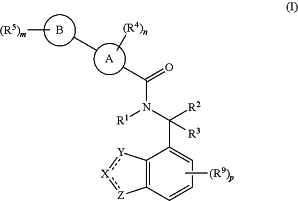| CPC C07D 231/56 (2013.01) [C07D 235/06 (2013.01); C07D 401/12 (2013.01); C07D 403/12 (2013.01); C07D 405/12 (2013.01); C07D 413/12 (2013.01); C07D 417/12 (2013.01); C07D 471/04 (2013.01)] | 9 Claims |
|
1. A compound of Formula I:
 or a pharmaceutically acceptable salt thereof;
wherein
X, Y, and Z, together with the ring to which they are attached, form
 Ring A is selected from the group consisting of phenyl, 5-6 membered heteroaryl, C4-10 cycloalkyl, and 4-10 membered heterocycloalkyl;
Ring B is selected from the group consisting of phenyl, 5-6 membered heteroaryl, C3-6 cycloalkyl, and 3-6 membered heterocycloalkyl;
alternatively, Ring B is absent and m is 0;
R1 is selected from the group consisting of H, C1-6 alkyl, and C3-6 cycloalkyl, wherein alkyl and cycloalkyl are each optionally substituted with R6;
R2 and R3 are each independently selected from the group consisting of H, C1-6 alkyl, C3-6 cycloalkyl, and 3-6 membered heterocycloalkyl;
alternatively, R2 and R3, together with the atom to which they are attached, form a ring selected from the group consisting of C3-7 cycloalkyl and 3-7 membered heterocycloalkyl;
each R4 is independently selected from the group consisting of C1-6 alkyl, halo, —OH, —OR6, —NH2, —NH(C1-6 alkyl), —N(C1-6 alkyl)2, —NHCOR6, —CN, C1-6 haloalkyl, C3-7 cycloalkyl, 3-7 membered heterocycloalkyl, and —COR6;
each R5 is independently selected from the group consisting of H, C1-6 alkyl, C1-6 haloalkyl, halo, —OH, —OR6, —NH2, —NH(C1-6 alkyl), —N(C1-6 alkyl)2, —NHCOR6, —CN, C3-7 cycloalkyl, 3-7 membered heterocycloalkyl, —COR6, and —SO2R6;
alternatively, two R5, together with the atoms to which they are attached, form a ring selected from the group consisting of phenyl, 5-6 membered heteroaryl, C4-6 cycloalkyl, and 4-6 membered heterocycloalkyl all of which are optionally substituted with one, two, or three R7;
each R6 is independently selected from the group consisting of C1-6 alkyl, C0-6 alkyl-C6-10 aryl, C0-6 alkyl-5-10 membered heteroaryl, —OC1-6 alkyl, C3-6 cycloalkyl, halo, —NH2, —NH(C1-6 alkyl), and —N(C1-6 alkyl)2;
each R7 is independently selected from the group consisting of C1-6 alkyl, C1-6 haloalkyl, halo, —OH, —OC1-6 alkyl, —NH2, —NH(C1-6 alkyl), —N(C1-6 alkyl)2, —CN, —COR8, and —SO2R8;
each R8 is independently selected from the group consisting of C1-6 alkyl, —OC1-6 alkyl, halo, —NH2, —NH(C1-6 alkyl), and —N(C1-6 alkyl)2;
each R9 is independently selected from the group consisting of C1-6 alkyl, —OC1-6 alkyl, halo, —CN, —OH, —NH2, —NH(C1-6 alkyl), and —N(C1-6 alkyl)2;
m is 0, 1, 2, or 3;
n is 1, 2, or 3; and
p is 0, 1, 2, or 3.
|